


 |  |  | Do babies mattter? |
Authors Marc Goulden (speaker), Mary Ann Mason, Nick Wolfinger
Copyright ©2004 by M. Goulden, M. A. Mason, and N. Wolfinger.
3
In the last four decades, women have made impressive strides in achieving equity in the academy. In 1966 (NCES), women comprised just 43% of baccalaureate degree recipients; 34% of Master's degree recipients; and a mere 12% of doctoral degree recipients (among U.S. citizens). Most recently, women comprised a remarkable 57% of all baccalaureate degree recipients (2001), 59% of master's degree recipients (2001); and 51% of doctoral degree recipients (U.S. citizens only, 2002). Feminists of earlier generations deserve a great deal of credit for ushering in this age of greater access for women. In contrast to this clear pattern of increasing feminization among U.S. degree recipients, the degree to which the professoriate has feminized is less impressive. Women are now well represented among non-tenure-track faculty (perhaps a dubious mark of glory) at 49%, and are fairly well represented among pre-tenure faculty, at 45% of assistant professors on the tenure-track. But women remain a mere 26% of tenured faculty in the United States (NCES 1999).
The realization that women PhDs might be hitting some sort of barrier in their pursuit of tenure or may be leaking out the pipeline at disproportionately higher rates than men led us to the formation of our current research effort, referred to as the "Do Babies Matter?" project (Mason and Goulden 2002).
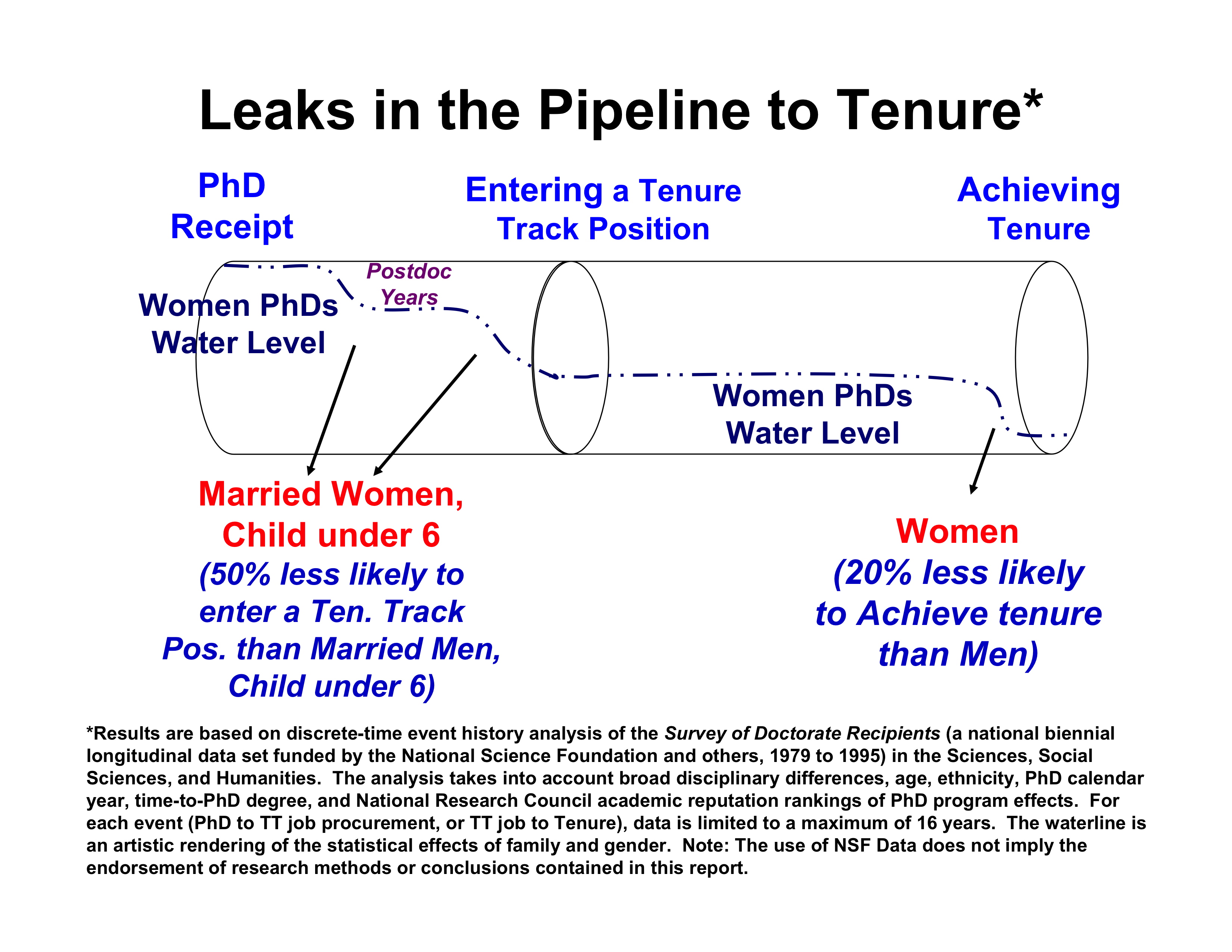
In the last three years, we have undertaken extensive analysis of SDR data regarding the effect of family formation on men's and women's rates of academic progression and have been able to pinpoint more closely when women leak out of the pipeline to tenure (Mason and Goulden 2002; Wolfinger, Mason, and Goulden 2004). Using discrete-event analysis (Allison 1995) and controlling for broad disciplinary field, age at PhD, prestige of PhD program (National Research Council program rankings), time-to-PhD degree, calendar year of PhD, and ethnicity, we conducted two separate assessments: the effect of gender and family formation on the year-to-year likelihood of (1) men and women PhDs entering a tenure-track position after the PhD and (2) tenure-track men and women achieving tenure. Based on these two analyses, we found that family patterns had a strong effect on the probability of women entering a tenure-track position, but family patterns had no clear independent effect on determining whether tenure-track faculty eventually achieve tenure. Rather, all tenure-track women were less likely eventually to achieve tenure than were tenure-track men. By converting the findings from these two regression models (Wolfinger, Mason, Goulden 2004) to expected probabilities for each of the possible career outcomes, tenure-track entry and the achievement of tenure, the extent of problems in the pipeline to tenure for women, particularly ones with family-related concerns, became clear.
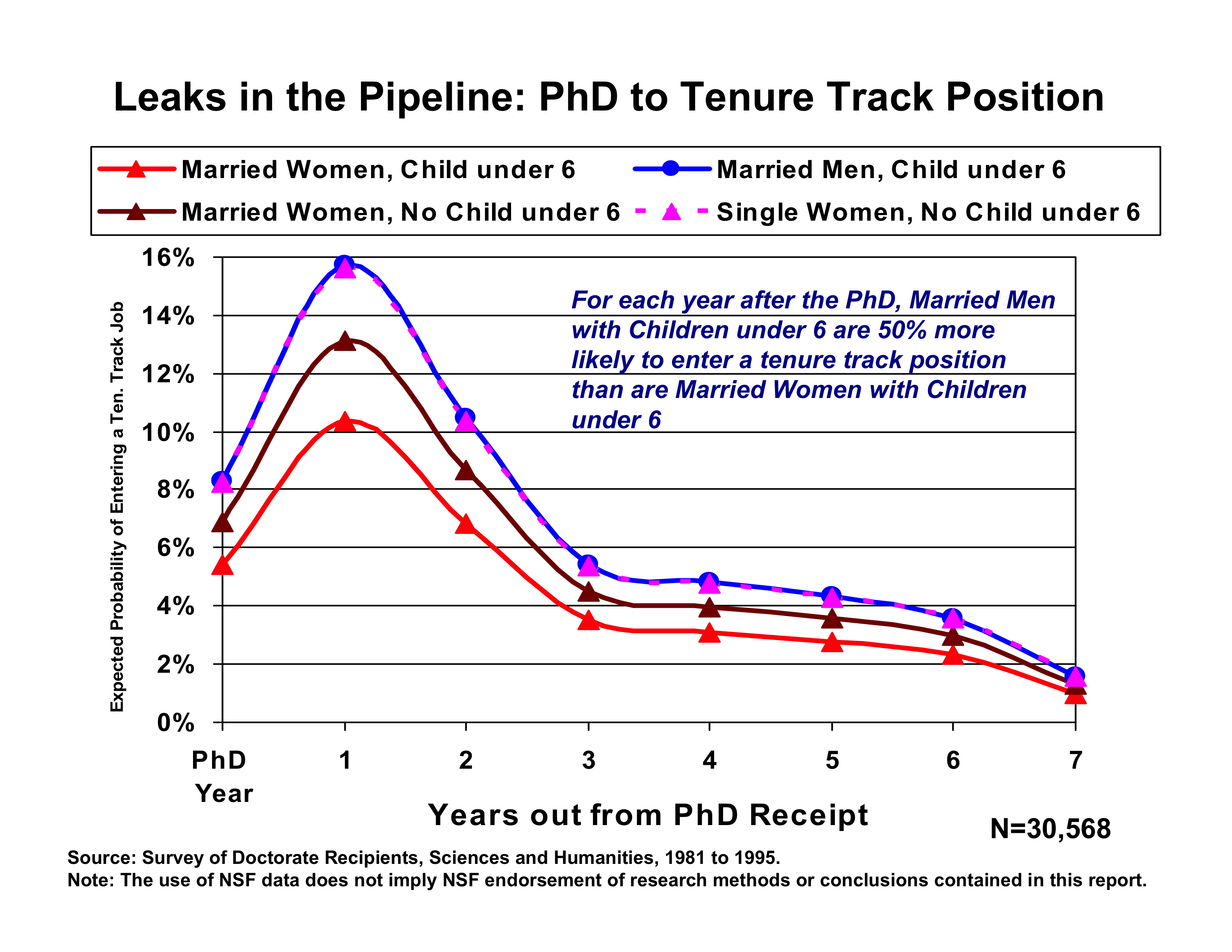
The figure shows the year-by-year expected probability of different gender-family groups entering a tenure-track position. In the first year out from the PhD, the high water mark of tenure-track job entry, 16% of married men with children under 6 and 16% of single women without children under 6 are expected to enter a tenure-track position. In contrast, only 13% of married women without children under 6 and a paltry 10% of married women with children under 6 are predicted to do so. Thus, married men with children under 6 are 50% more likely than married women with children under 6 to join the ranks of tenure-track faculty in the first year out from the PhD; this increased likelihood holds steady for all years after receipt of the PhD. Because single women without children under 6 do as well as married men with children under 6, family formation completely explains why women are overall less likely than men to enter tenure-track positions (Wolfinger, Mason, and Goulden 2004). The message is clear: for women, babies and marriage, particularly in combination, dramatically decrease their likelihood of entering a tenure-track faculty position.
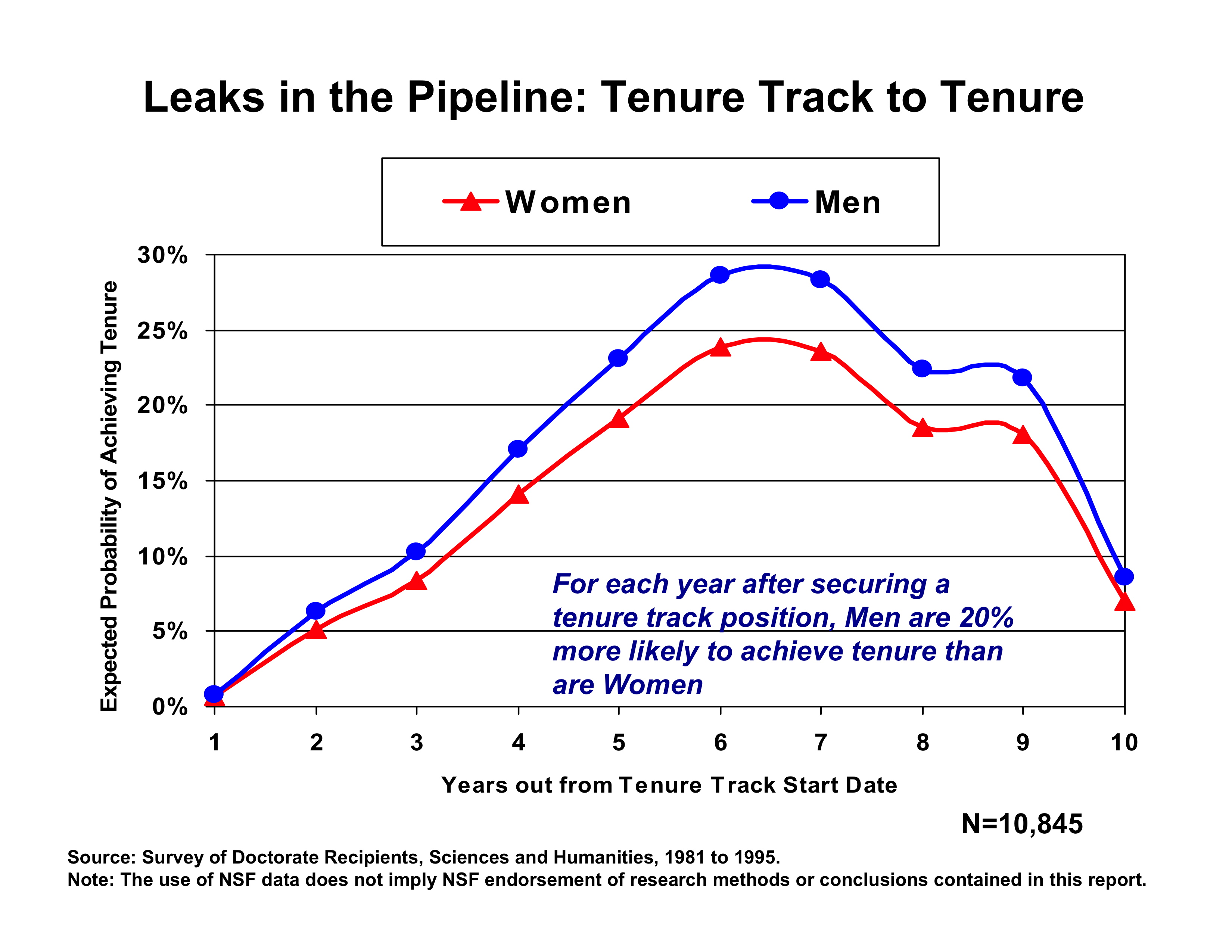
Once women enter a tenure-track position, family effects alone no longer explain their decreased likelihood of continuing on in the pipeline to tenure. Rather, tenure-track women regardless of family status are less likely than tenure-track men to eventually become tenured. On a year to year basis, men are 20% more likely to achieve tenure than are women. We do not know why this is true, but theorize that other factors such as discrimination may be at work (e.g. Valian 1998). From a pipeline/resource related issue, this second leak for women, the tenure-track to tenure leak, is troubling, but the first leak is even more worrisome because it is earlier in the pipeline and thus has a compounding effect. Achieving tenure is obviously preconditioned on entering a tenure-track faculty position and thus married women, particularly ones with young children, are lost to the professoriate within a first few years after the receipt of the PhD.
The preceding discussion on the effects of family patterns on the academic careers of men and women PhDs raises an obvious question: Should women PhDs delay marriage and fertility until after they have secured a ladder-rank faculty position so as to maximize their likelihood of enjoying both a robust career and family life? Using data from the SDR and a second data source, the University of California Work and Family survey (Mason, Stacy, and Goulden 2004), we have recently examined precisely this issue.
Our analysis of data from the SDR demonstrates that ladder-rank faculty careers have significantly different effects on the family patterns of men and women PhDs (Mason and Goulden 2004). To begin with, when controlling for major disciplinary field, age at PhD, prestige of doctoral program, time-to-degree, and ethnicity, ladder-rank faculty women are much less likely to be married or to have a child under 6 in the household at time of career formation -within three years post-PhD- than are ladder-rank faculty men or ‘second-tier' women (women working in non-tenure-track faculty positions or part-time positions within or outside academia or not working).
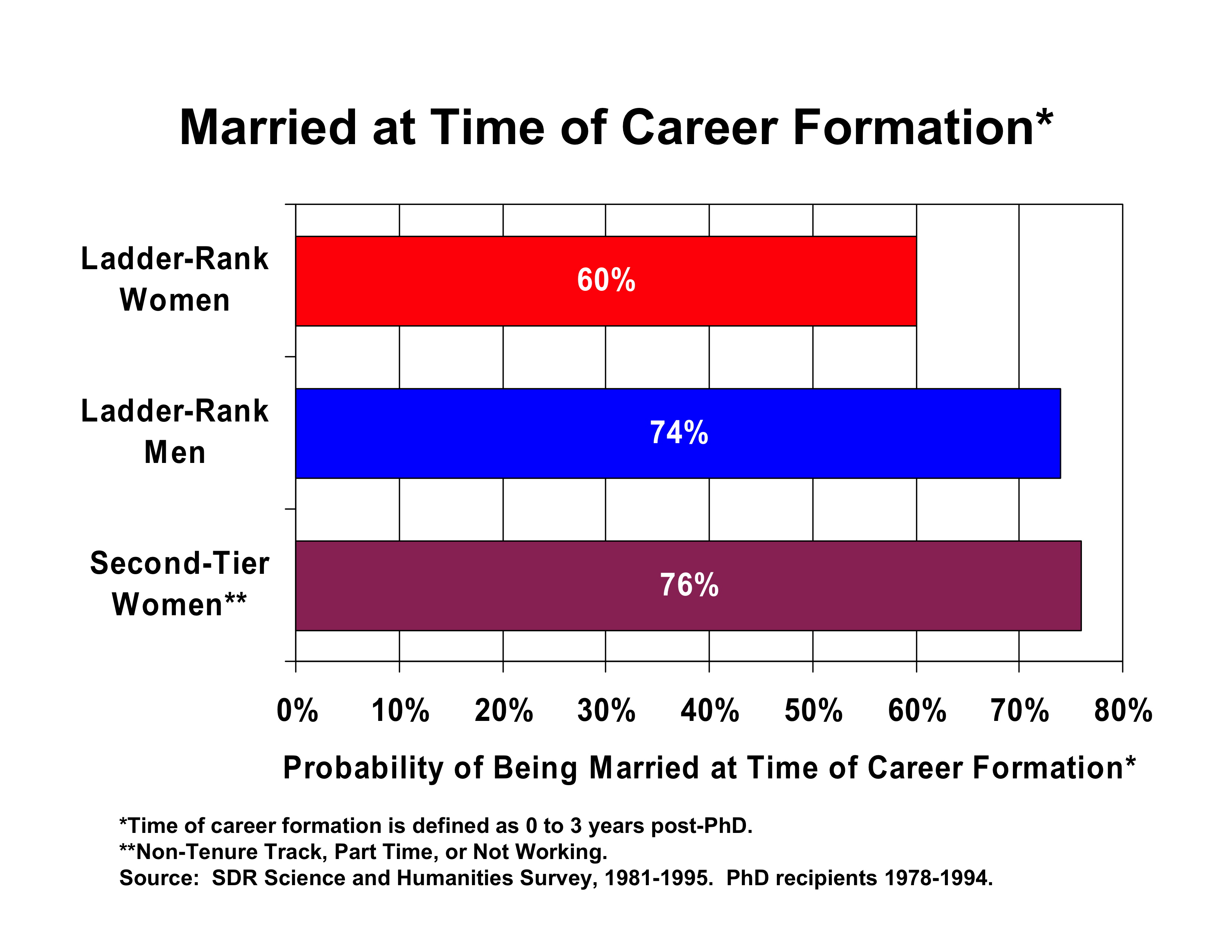
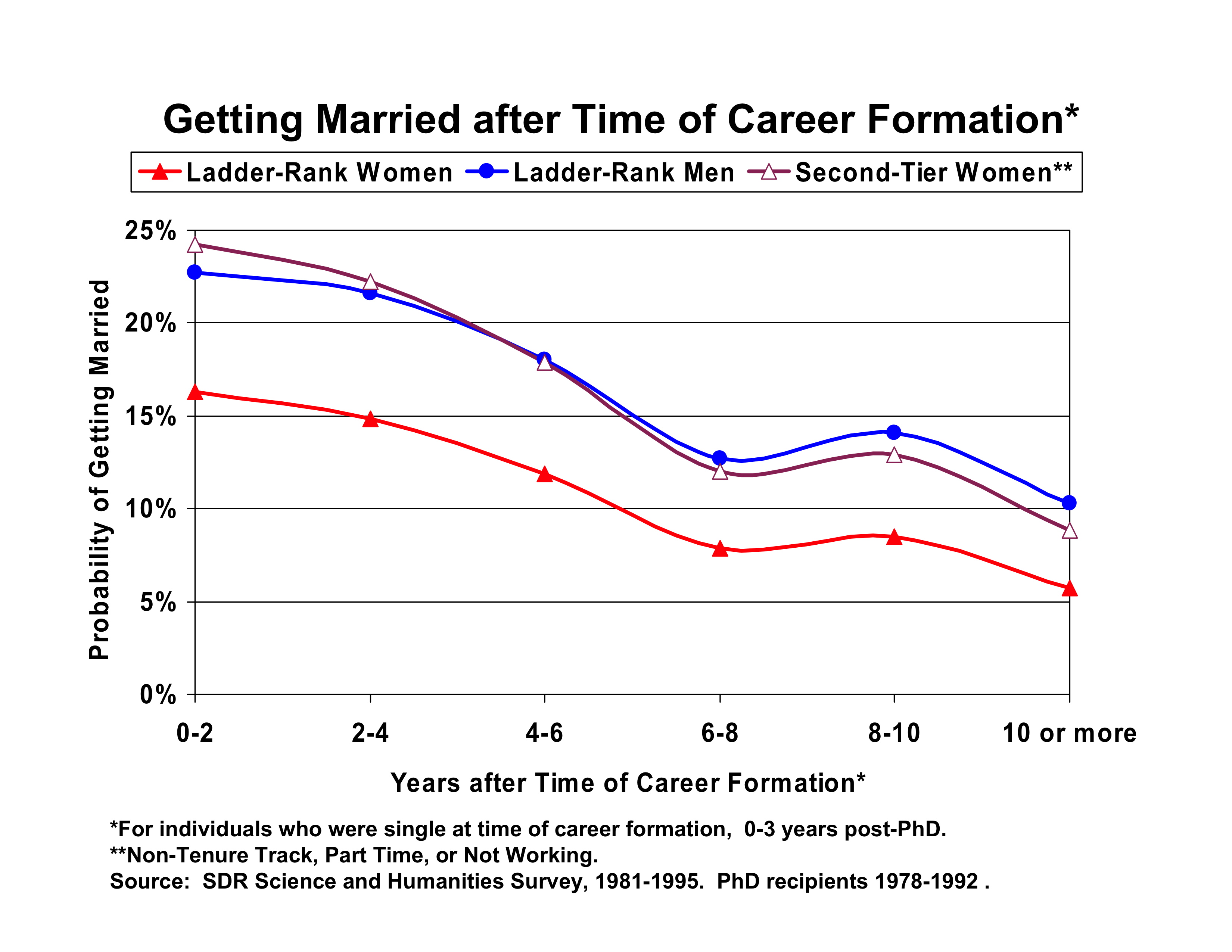
Moreover, as their careers progress, single ladder-rank women are significantly less likely than are single ladder-rank men and single second-tier women to get married.
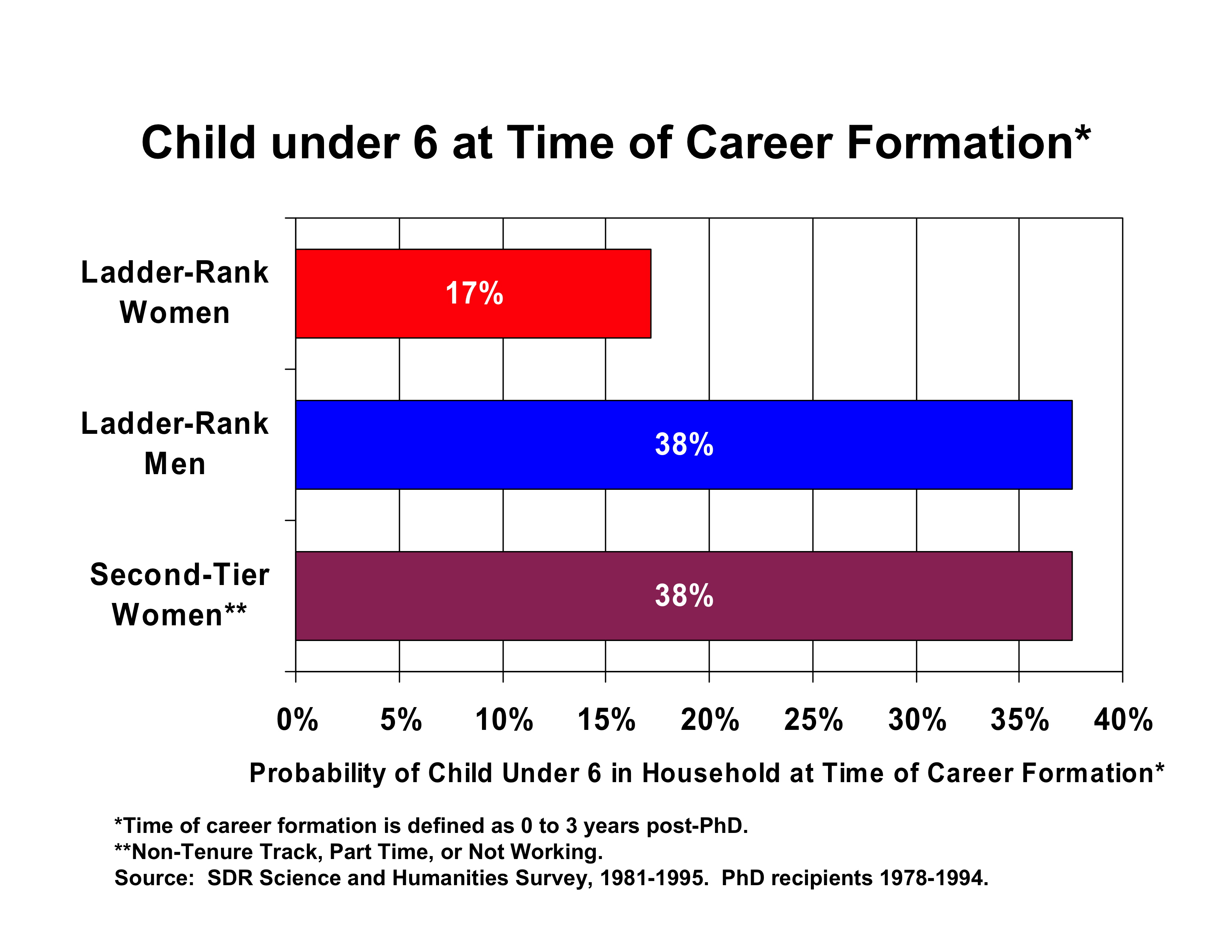
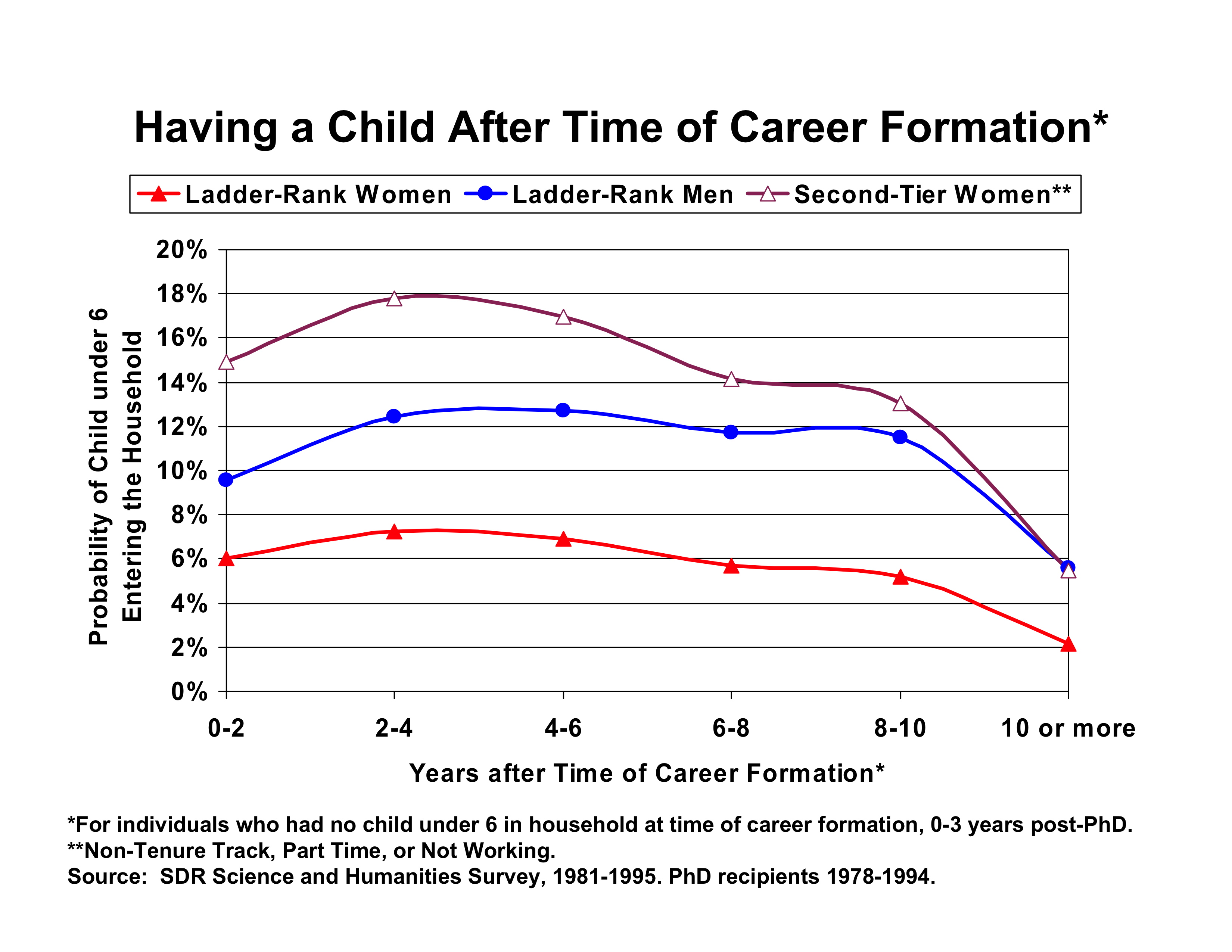
Following the same pattern of lowered rates of family formation, ladder-rank women without children under 6 are much less likely than are ladder-rank men and second-tier women to have child under 6 enter the household after the time of career formation.
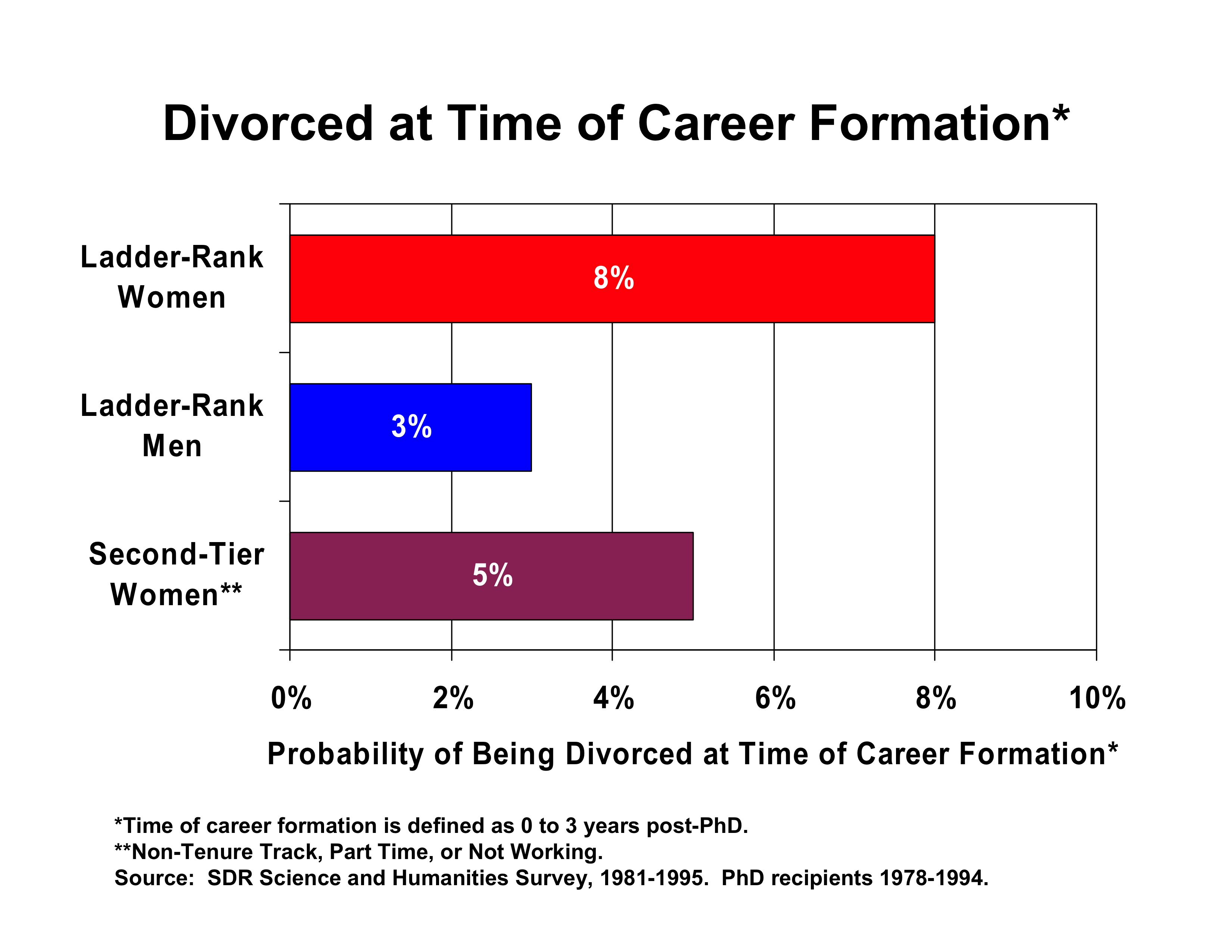
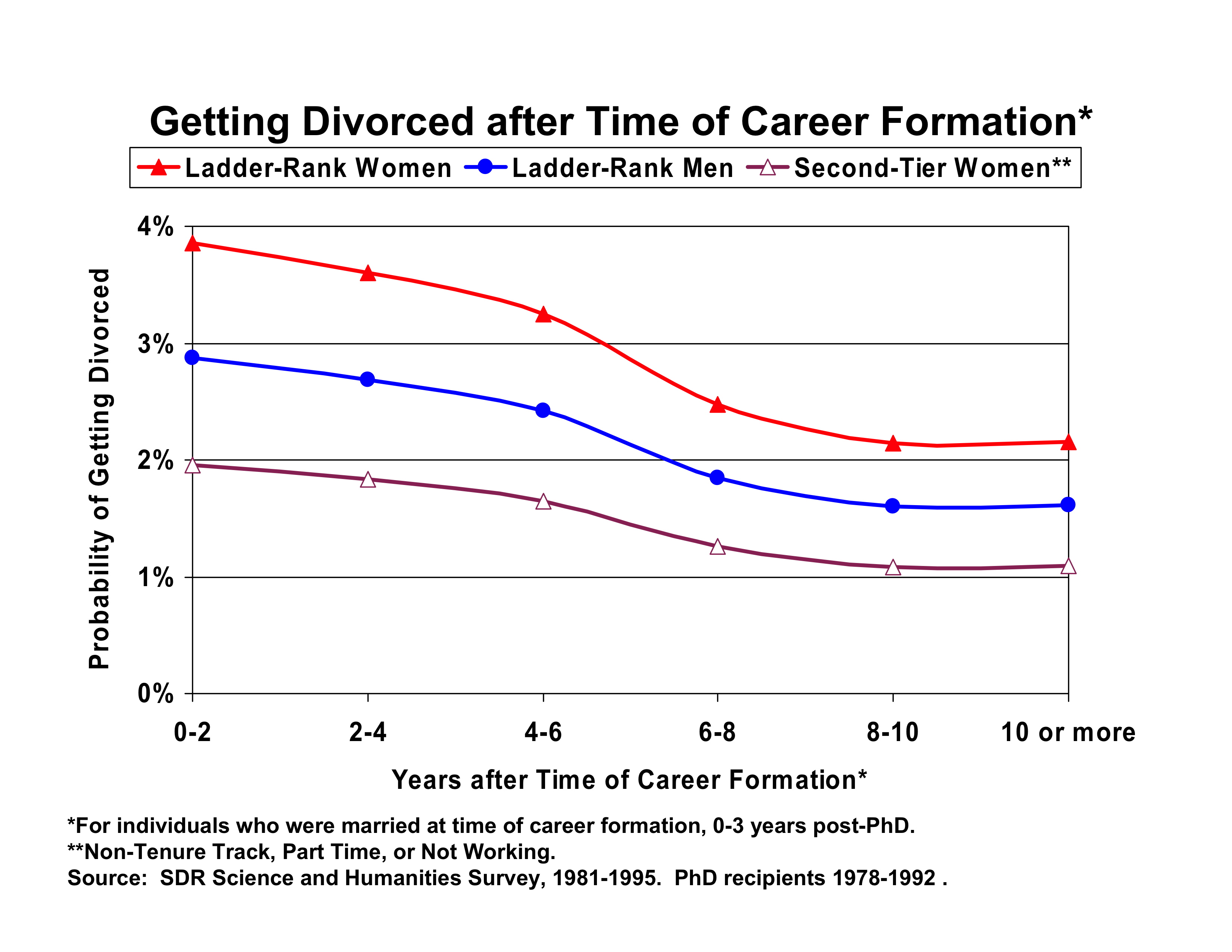
In fact, ladder-rank women are much more likely to be divorced than are ladder-rank men or second-tier women at time of career formation. Lastly, married ladder-rank women are much more likely than are married ladder-rank men and married second-tier women to become divorced as their careers progress, and divorced ladder-rank faculty women are less likely than divorced ladder-rank men and divorced second-tier women to remarry.
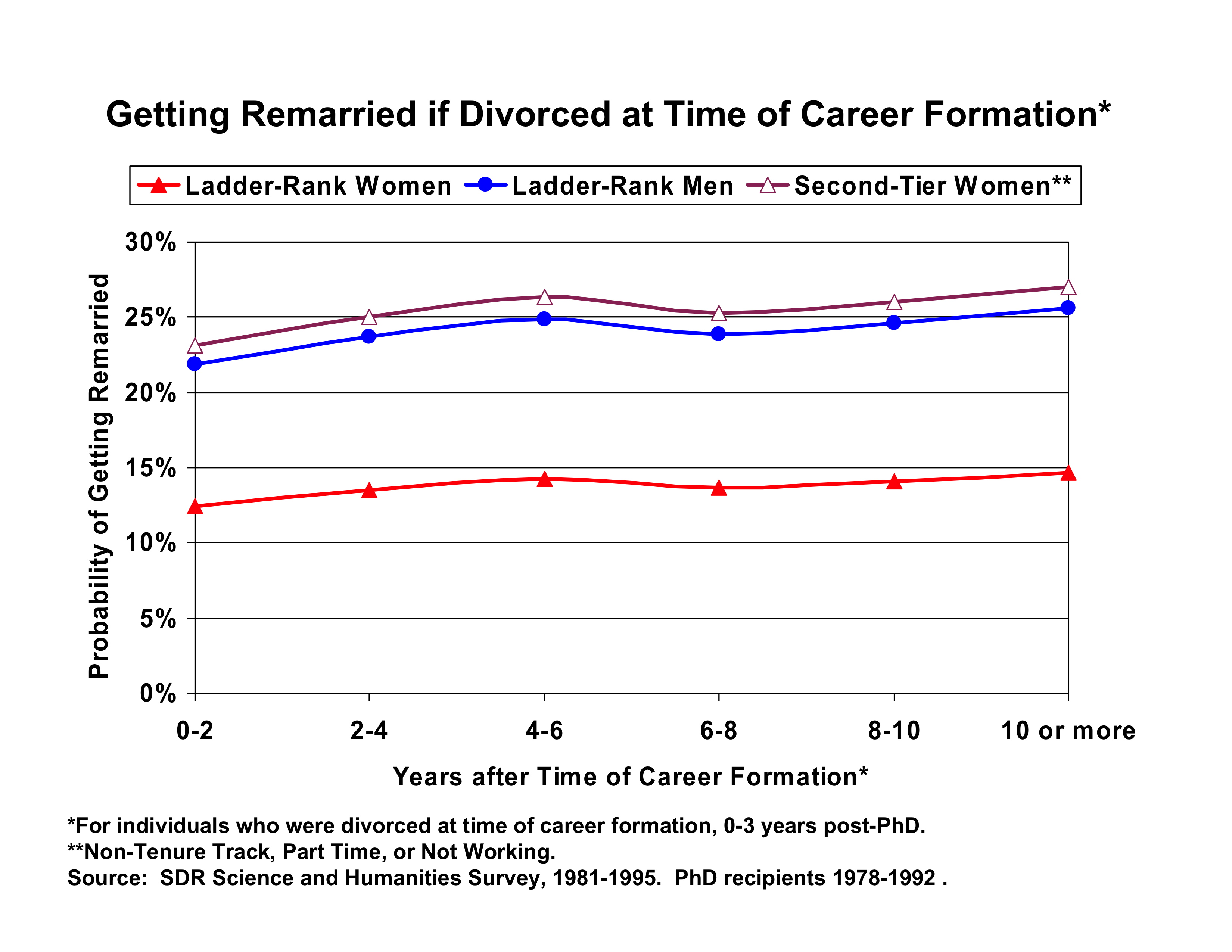
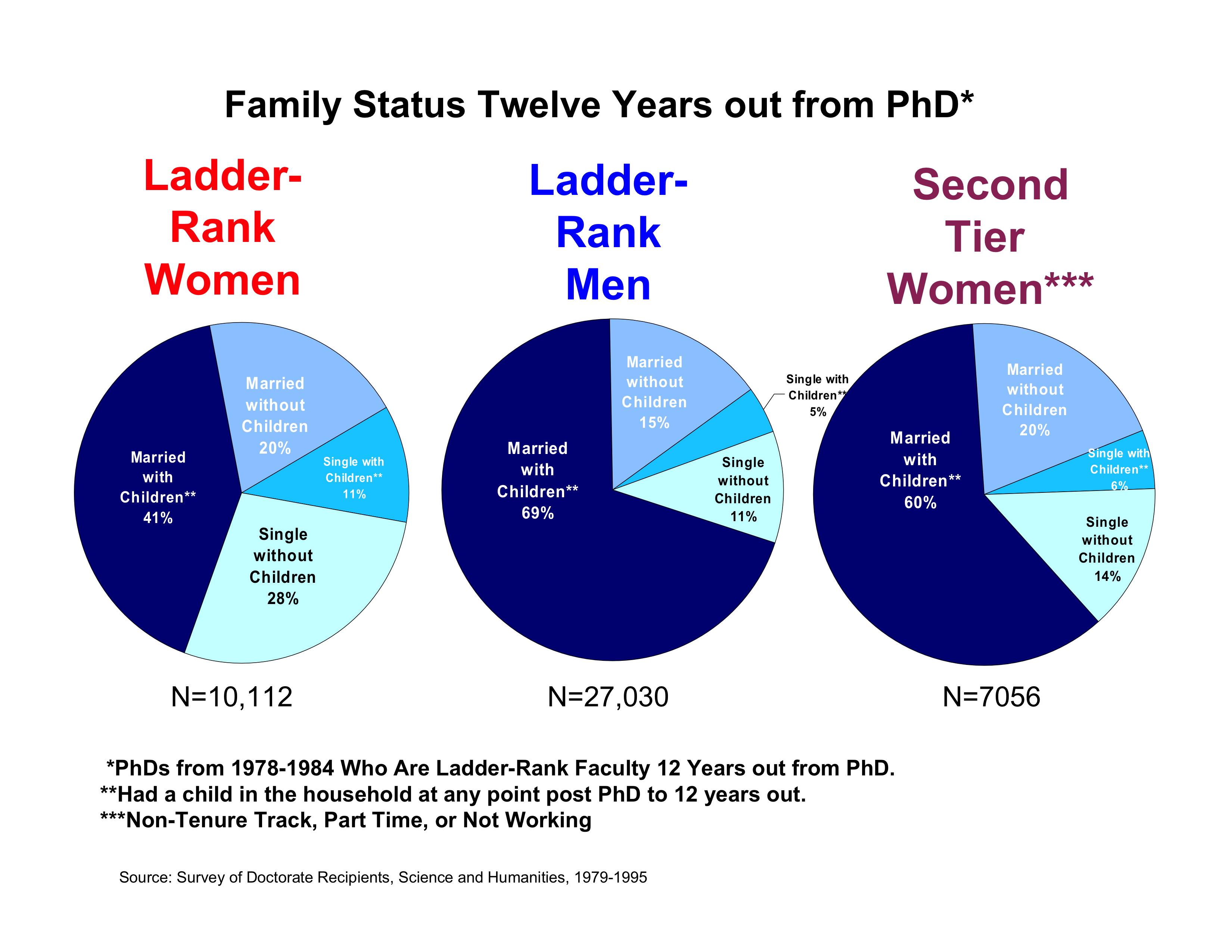
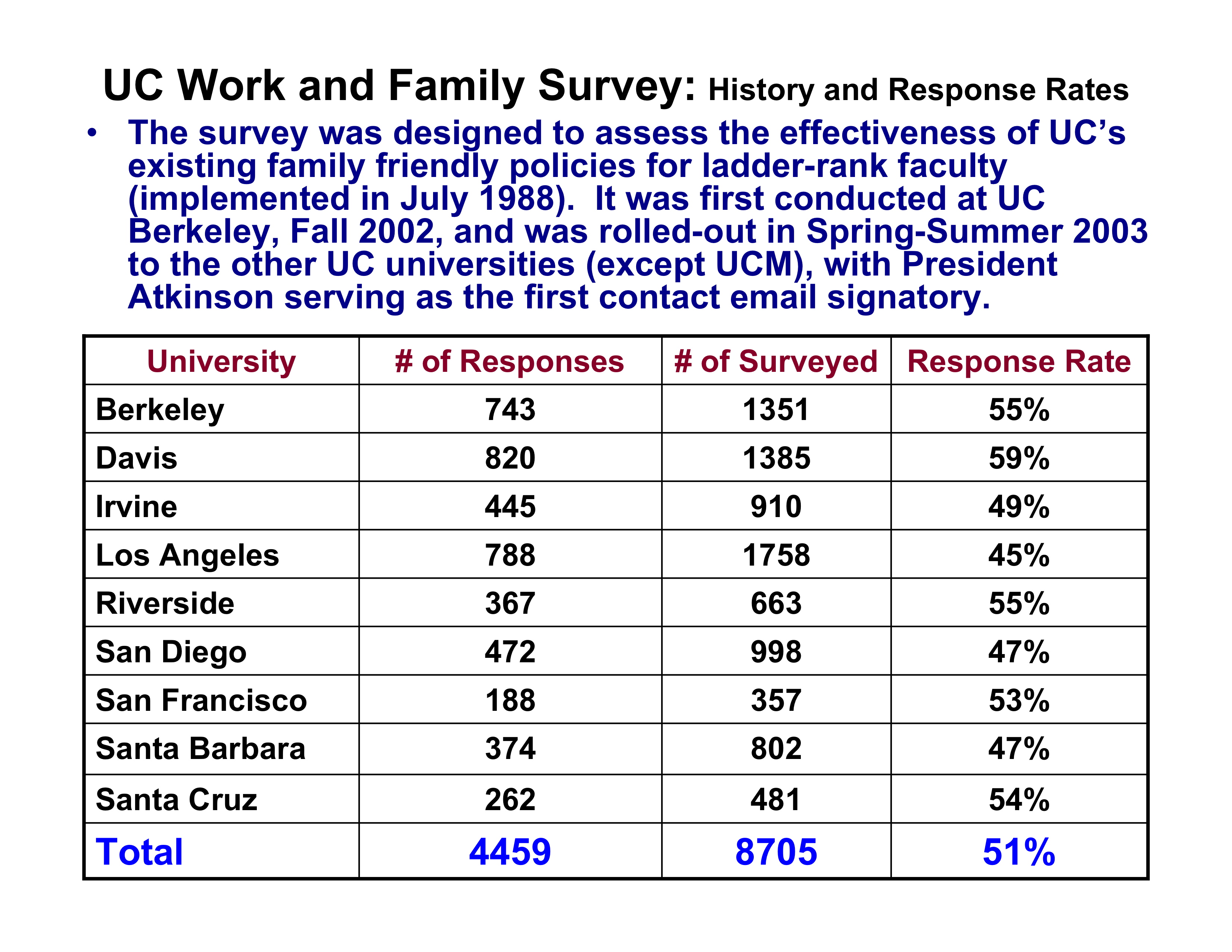
Data from the UC Work and Family survey on hours worked each week on professional duties, providing care to others, and household activities suggest that women faculty ages 30 to 50, with children, are experiencing a time bind more than are other groups. These mothers log on average more than 100 hours a week on the combined activities, easily outpacing men ages 30 to 50, with children, who nonetheless register an impressive 88 hours a week. UC men and women without children are also very busy but not nearly as busy, topping around 78 hours a week. Given these types of time demands, women doctoral candidates, post-doctoral fellows, and assistant professors without children within the UC system must wonder how easy it would be to reconcile the demands of both career and parenting.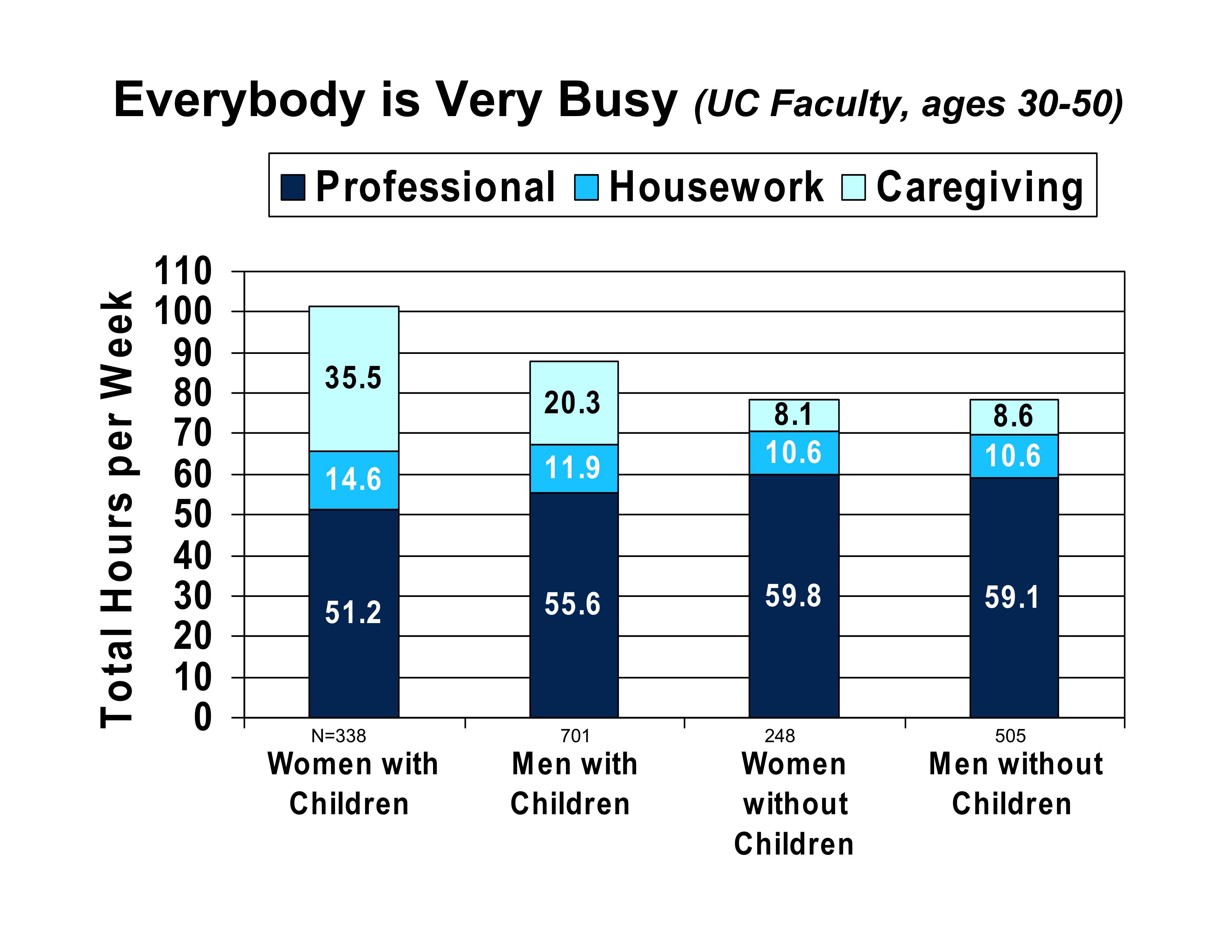
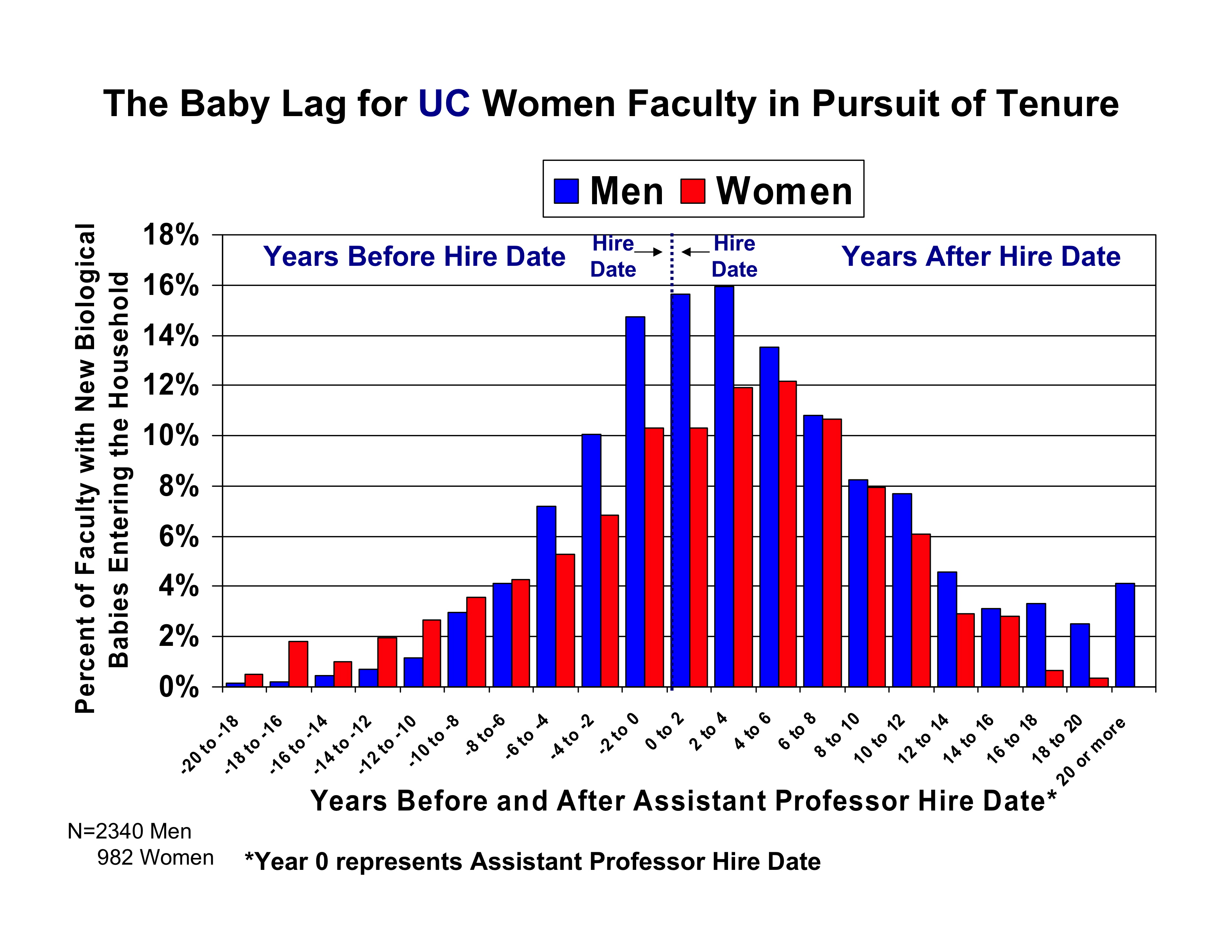
By taking the same birth history data and fixing it to respondent's age at birth of children, the differences in fertility patterns of UC women and men faculty are even clearer. From age 22 to 36, UC faculty men are more likely than UC faculty women to have babies. Women faculty, however, are more likely to have babies from age 36 to 40. This data suggests that UC faculty women may be delaying child birth until their mid-to-late thirties. After age 40, men faculty are again more likely to have biological babies than are women faculty, no doubt because of biological constraints that disproportionately affect women after the age of 40. (Again, this preceding section is included in: Mason and Goulden 2004).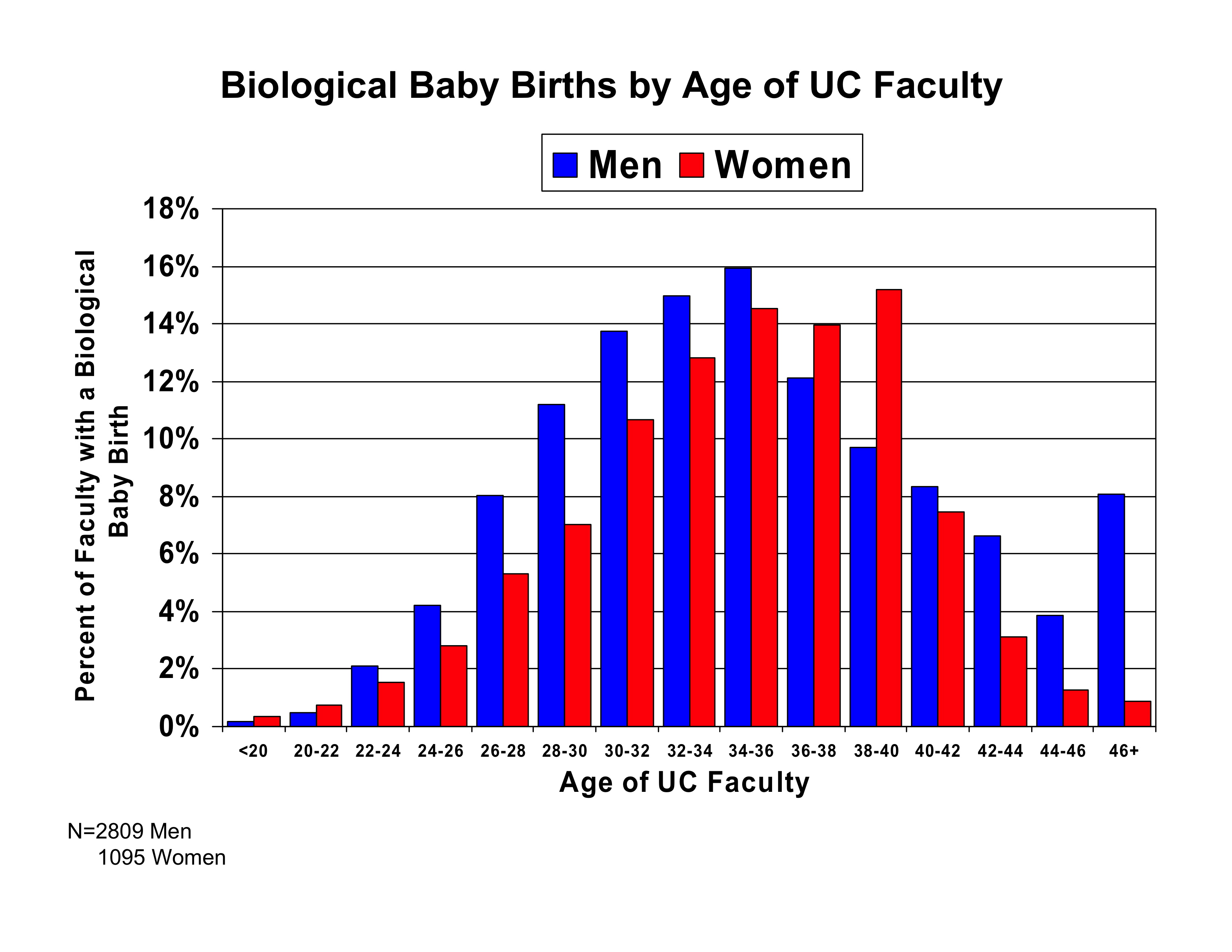
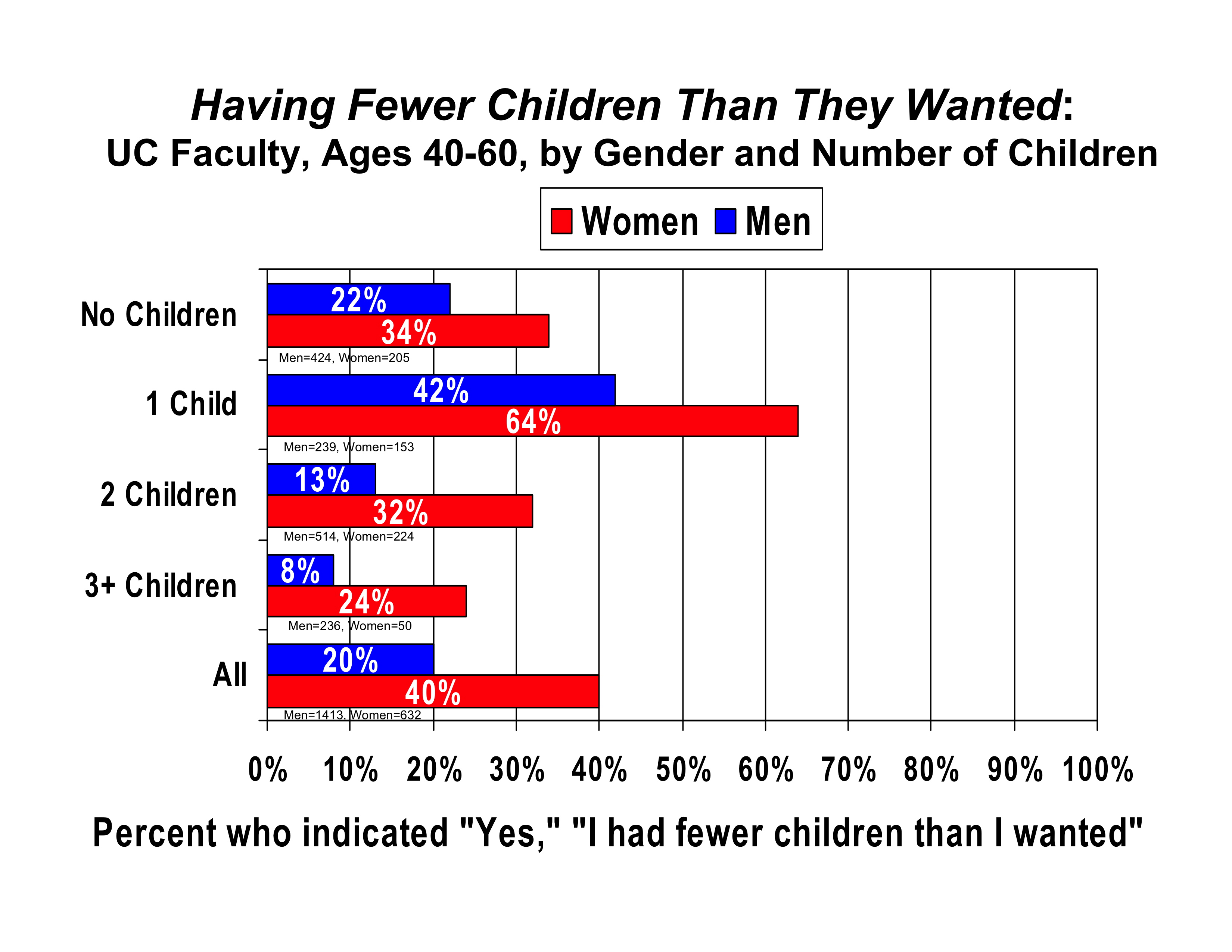
As part of the UC Work and Family survey, we asked faculty about their use of family friendly policies. We found that among eligible UC women and men faculty, individuals who had experienced a birth/adoption event after the policies were in place, the use rates were lower than one might hope. Specifically, 52% of eligible women who already had tenure at the time of the birth/adoption event made use of ASMD and only 45% of pre-tenure women at time of event did so. Among men, the use rates were quite low: only 8% of eligible tenured men made use of ASMD and 7% of pre-tenure men. Tenure-clock extension was used even less, with just 30% of eligible pre-tenure women and 8% of pre-tenure men using the policy. When we asked eligible UC women and men why they did not use the policies, two major issues came up: lack of knowledge about the policies and fear of using them. With a multi-year grant from the Alfred P. Sloan Foundation, we are now seeking to enhance UC's existing family-friendly policies, propose additions to the polices and available family-friendly resources, and encourage a family-friendly culture within the UC. Work is already under way by the University of California Office of the President to make two key changes to the existing policies:
Additionally, there is a proposal to allow ladder-rank faculty the option of going part-time for limited periods of service (e.g., up to five years) as life-course needs arise, including birth/adoption events, other parenting issues, personal illness, adult dependent care responsibilities, and phased retirement. We also know from the UC Work and Family survey that high quality, readily available childcare and infant care facilities, regular and emergency, are extremely important to faculty parents. We are suggesting, therefore, that the University of California needs to consider this to be part of the necessary infrastructure of a premier institution. If parking spaces can be considered in all new building plans, perhaps child care and infant care slots should be part of the equation too. Facilities on or near campuses save faculty parents time and help to minimize the time-bind that many faculty parents, particularly mothers, experience.
As part of a larger focus on the institutional culture of the UC community, we also recommend that every campus have in place a work and family advisery committee and host an annual school for new department chairs, which would serve the purpose of ensuring that the front-line administrators who are directly involved with the use of family-friendly policies would fully understand their appropriate use. This is particularly important given the high turn-over rate among chairs and the fact that - as data from the Work and Family Survey show - department chairs play a pivotal role in the interpretation of policies, sometime taking on a gatekeeper role.
Lastly, to assist in the relocation of new faculty hires and to help with recruitment, particularly for married women who are much more likely than married men to have a spouse with a full-time career, we propose that all campuses have in place a relocation specialist who can provide faculty recruits with counsel and resources related to spousal employment, schools, housing, and so forth. No single policy or resource will be a panacea, so we are proposing a package concept that helps to meet faculty's needs as their life and family situation changes over time. With the UC Family Friendly Package in place, we believe that we will be well-positioned to encourage women to stay in the pipeline to tenure and enjoy a satisfied work and family life as a UC professor.
REFERENCES
Allison, Paul D. 1995. Survival Analysis using the SAS System: A Practical Guide. Cary, North Carolina: SAS Institute, Inc.
Mason, Mary Ann, Angelica Stacy, and Marc Goulden. 2003. "The UC Faculty Work and Family Survey." Data source.
Mason, Mary Ann, and Marc Goulden. December 2002. "Do Babies Matter: The Effect of Family Formation on the Lifelong Careers of Academic Men and Women." Academe 88, Number 6: 21-27.
Mason, Mary Ann, and Marc Goulden. 2004. "Marriage and Baby Blues: Re-defining Gender Equity in the Academy." The Annals of the American Academy of Political and Social Science. Forthcoming. National Center for Education Statistics. 2003. "The Integrated Postsecondary Education Data System (IPEDS) Completions Survey." Washington, DC: NCES.
Mason, Mary Ann, and Marc Goulden. 2001. "The Integrated Postsecondary Education Data System (IPEDS) Salaries, Tenure, and Fringe Benefits of Full-Time Instructional Faculty Survey." Washington, DC: NCES.
National Science Foundation. 1995. "Changes to the Survey of Doctorate Recipients in 1991 and 1993: Implications for Data Users.”
Mason, Mary Ann, and Marc Goulden. 1999. "Characteristics of Doctoral Scientists and Engineers in the United States: 1997." Arlington, Virginia: NSF.
Mason, Mary Ann, and Marc Goulden. 2004b. "Survey of Doctorate Recipients." http://www.nsf.gov/sbe/srs/ssdr/start.htm
Valian, Virginia. 1998. Why So Slow?: The Advancement of Women. Cambridge, Mass.: The MIT Press.
Williams, Joan. 2000. Unbending Gender: Why Family and Work Conflict and What to Do About It. Oxford: Oxford University Press, 2000.
Wolfinger, Nicholas, Mary Mason, and Marc Goulden. 2004. "Problems in the Pipeline: Gender, Marriage, and Fertility in the Ivory Tower." Unpublished paper.
 |  |  | Do babies mattter? |